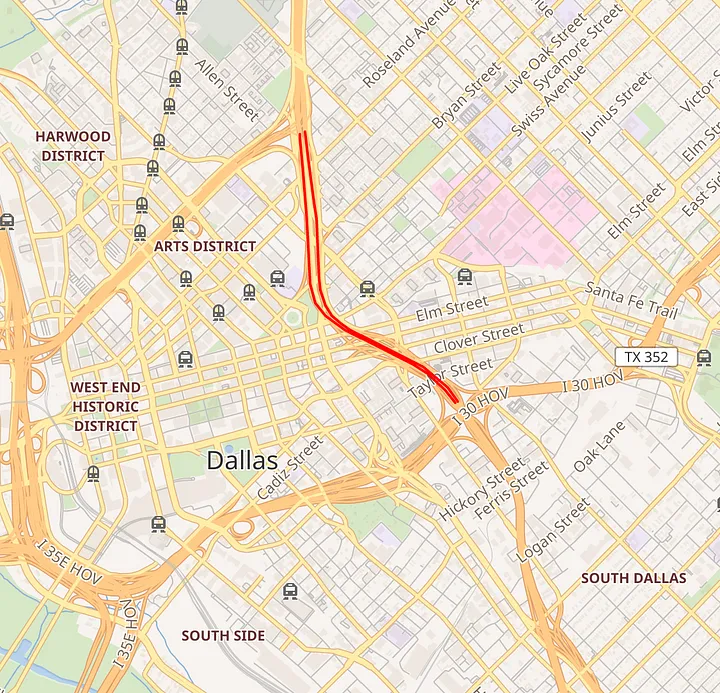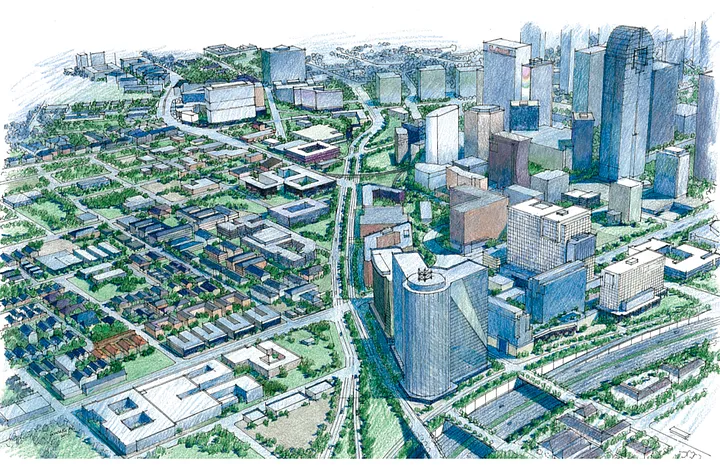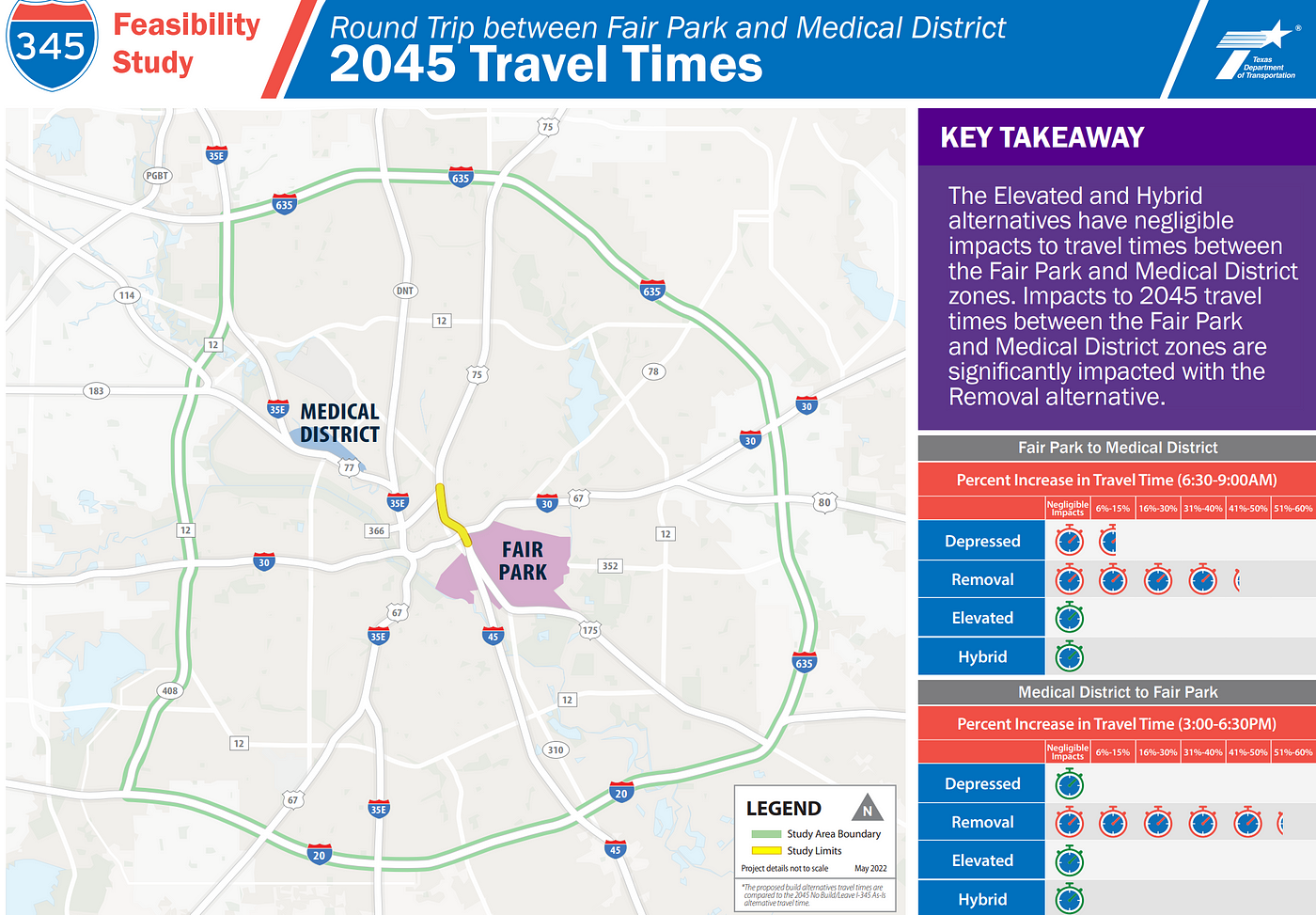Interstate 345 Would Close 5 Years (Possibly 12) If Construction of TxDOT Hybrid Plan is Approved
TxDOT hides estimated construction time in feasibility study and never mentions its 5-year impact on traffic.
By Hexel Colorado on July 7, 2022
What’s the situation?
Dallas must decide the fate of Interstate 345, a 50-year-old elevated freeway in Downtown Dallas, as it approaches end-of-life. In June, last month, TxDOT released a feasibility study on possibilities for the deteriorating freeway.
The study reported on five alternatives, but the “Hybrid” alternative was selected as TxDOT’s official recommendation before last month’s public hearing. This plan would rebuild the highway inside a trench 60-feet below grade. It would retain the same number of main lanes and connections to other highways. The right-of-way would not change— the highway would take up no less and no more land than it does now.

Rendering from 2016 CityMAP report showing what Dallas could look like if I-345 were removed.
Before recent study, the idea of permanent removal had serious support.
Since 2013, advocacy groups Coalition for a New Dallas and Congress for New Urbanism have called for removing the 1.4-mile highway and opening 245 acres of land for development. A separate TxDOT study in 2016 reported that a removal plan would bring 12,000 people and 40,000 jobs to the city, earn Dallas $80 million in additional revenue, and improve transit, bike and pedestrian access. For these reasons, 12 city councilmembers said last year they supported “removing I-345 and replacing it with a mixed-use, mixed-income neighborhood that restores the community grid and reconnects East and South Dallas.”

Rendering from 2016 CityMAP report showing what Dallas could look like if I-345 were removed.
Frightening traffic numbers in feasibility study changed city leaders’ minds about removing I-345.
Despite the wealth of long-standing evidence that highways cutting through the center of a city are a principal cause of urban decay, hesitance persisted among city leaders. Fear of increased traffic congestion has always been the bane of highway removal ambitions.
TxDOT tapped into those fears with their traffic analysis of a new “Removal alternative” designed for the feasibility study. They predicted their Removal plan would increase travel time by 40% to 60% for various trips across the city. In contrast, they predicted essentially no impact on traffic from their Hybrid alternative. Their assessment was enough to annul support of removal among members of City Council and rally support toward their Hybrid plan.
“When you start to tell residents they’re going to get an average of forty percent more time added to their commute, everybody is gonna sit there and go, ‘Ahhh! I don’t want that!’” — Councilman Omar Narvaez

One of ten graphs predicting significant impact on traffic by the Removal alternative prepared by TxDOT for their latest feasibility study.
Traffic impact due to construction is completely ignored in Feasibility Study.
TxDOT made zero mention of traffic impact from construction in their feasibility study. Their estimated 5 years of construction is not mentioned until the second to last slide in their study presentation. There is zero mention of construction on the project website. There is zero mention of construction on the double-sided FAQ handed out at the public hearing. This major omission was made despite traffic being the deciding factor behind TxDOT’s recommendation of the Hybrid alternative.
It’s impossible to keep the elevated highway open while digging a trench beneath it.
I suspect no one made a big fuss about these details being missing because it’s typical to keep a few freeway lanes open during highway expansion projects. The I-30/SH-360 interchange in Arlington has been under construction for the last eight years and traffic (slowly and painfully) flows through.
However, the Hybrid plan doesn’t elevate or widen the freeway; the plan is to bury the freeway. I’m no civil engineer, but I think I-345 currently being an elevated bridge dashes any hopes of allowing cars to drive on it during its demolition. Under its present deteriorating condition, we can’t even run trains underneath during an inspection.
So, here’s the grand irony of all this: all those fears of Traffic Armageddon if we remove the highway? They apply to the Hybrid plan too.
Construction on Woodall Rodgers Freeway to build Klyde Warren Park. Photo from dfwfreeways.com.
Five years is low-balling — expect delays
A kid starting high school the year of Hybrid’s groundbreaking will have moved to college before the highway opens. That statement rings true even if we naively believe TxDOT’s estimate of 5 years. Assuming no further delays, it will have taken 9 years to build Arlington’s I-30 interchange. With that track record, is five years enough time for a much more complicated rebuild at the center of the city?
As if that wasn’t enough, TxDOT sells the idea of putting a lid on the newly buried highway. No mention of time or cost because such amenities are only mentioned as a sales pitch and outside Hybrid’s scope. It took 3 years to build Klyde Warren Park over Woodall Rodgers Freeway.
Put all our empirical estimates together (9 + 3) and we get 12 years of construction. That’s over a decade that working families in South Dallas can’t drive to jobs in the north.

Oh boy, commuters are going to love sharing the road with these big boys for 5 to 12 years!
Interstate 345 Catch 22
Because both Removal and Hybrid require tearing out the highway, we can assume their traffic impact will be the same for at least 5 years.
If traffic impact is as catastrophic as it seems in the study, then Hybrid is not worth doing. How would Hybrid compensate families — commuters and non-commuters alike — after suffering years of travel delays on top of enduring the noise, pollution, and blight of construction?
On the flip side, the true impact on travel times isn’t as bad as TxDOT suggests. Based on their own numbers, the average increase in travel time is just 3 minutes. Also, keep in mind that highway removal’s impact on traffic is heavily influenced by the design of the street network that replaces it. If TxDOT had used their other removal plan from 2016, travel time increases would be even less significant
If Removal’s traffic impact is acceptable, then there is no advantage to going Hybrid; the responsible thing to do (fiscally, politically, and socially) is choose Removal to prevent years of blight and save money and time. Upon completion, Removal compensates the city in ways Hybrid can’t: new jobs, residences, and revenue.
Land freed by removal can transformed into a neighborhood center. Toole Design Group.
The decision at hand isn’t about removal versus burial — it’s about what we build in the limited time we have to enjoy it.
Whether it takes 12, 9, 5, or 2 years, everyone will adjust to life without I-345. Commuters will find new driving routes, take new jobs, move to the suburbs, transition to remote work, or retire. Employers will adjust expectations of their commuting staff. Shops may relocate. Both urban planners and traffic engineers understand that people always have and always will adapt.
I-345 sits at the heart of Dallas. Nowhere else can you find land encircled by Downtown, Uptown, the Arts District, Old East Dallas, Deep Ellum, and Fair Park. The decision at hand isn’t whether to “remove or bury” a highway. The choice is what to build after the highway is removed.
Do we build another highway for cars?
Or…
Do we build homes, businesses, parks, and vibrant places for people?